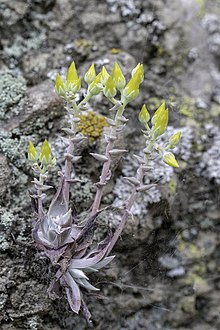
Dudleya abramsiisubsp. setchellii, known by common name as the Santa Clara Valley dudleya or Santa Clara Valley liveforever, is a member of the Dudleya genus of succulent perennials, members of the family Crassulaceae. The Santa Clara Valley dudleya, endemic to the Santa Clara Valley region in the southern San Francisco Bay Area, was listed on 3 February 1995, as an endangered species. It is considered to be a subspecies of Dudleya abramsii, but its taxonomic status is still unclear. Its closest relative is Dudleya cymosa subsp. paniculata, which is a morphologically similar sister taxon.

Dudleya caespitosa is a succulent plant known by several common names, including sea lettuce, sand lettuce, and coast dudleya. It is endemic to California, where it grows along the coastline in the southern half of the state. Taxonomically, this species is a highly variable complex of polymorphic and polyploid plants, closely related to numerous neighboring species such as Dudleya farinosa, Dudleya greenei and Dudleya palmeri. It is delimited from neighboring species on an arbitrary basis of distribution and chromosome number, and may not be immediately separable from the other species it approaches.

Dudleya densiflora is a species of succulent plant in the family Crassulaceae known commonly as the San Gabriel Mountains liveforever or San Gabriel Mountains dudleya. A very rare plant confined to the San Gabriel Mountains of Los Angeles County, California, it is known only from three to five spots in the mountain range, with an estimated 1,700 individual plants remaining. Growing in the cracks of the granite slopes of three canyons in this single mountain range, it is threatened by human activity such as rock quarrying and off-trail recreation.

Dudleya farinosa is a species of succulent plant in the family Crassulaceae known by several common names, including bluff lettuce, powdery liveforever, and powdery dudleya. A coastal plant of northern California and southern Oregon, it is typically found on oceanic bluffs just directly above the reach of the waves. Its appearance is characterized by lotus-like rosettes of beveled leaves, and in summer the plant erects a tall pink to red stem densely covered in foliage, topped with branches adorned with pale yellow flowers. The green or white rosettes of this plant can be seen covering stretches of rocky coast and nearby islets.

Dudleya lanceolata is a succulent plant known by the common name lanceleaf liveforever or lance-leaved dudleya. It is an extremely variable and widely ranging species that occurs from Monterey County and Kern County in California south through Ensenada in Baja California. It is characterized by green to purple lanceolate leaves, red, orange, or less commonly yellow petals, and is typically tetraploid. Despite its diversity, it is quite stable as a species, but hybrids may be discovered with other species of Dudleya, which can make it difficult to discern in areas where numerous species converge.
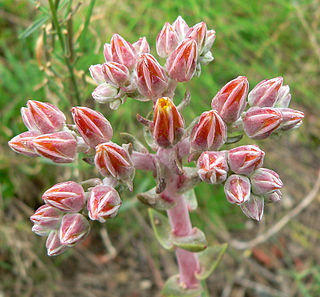
Dudleya palmeri is a species of succulent plant in the family Crassulaceae known by the common name Palmer's liveforever. This Dudleya is endemic to California where it grows along the coast. It is characterized by orange to red over yellow or pink flowers. It is a polyploid species that closely resembles Dudleya lanceolata but has a coastal habit, and hybridizes with Dudleya caespitosa and Dudleya cymosa.

Dudleya stolonifera is a succulent plant known by the common name Laguna Beach liveforever or Laguna Beach dudleya. This is a rare plant which is endemic to the coastline of Orange County, California. It is known from only about six populations in the vicinity of Laguna Beach, totaling about 30,000 individuals. It is federally listed as a threatened species of the United States.

Dudleya greenei is a perennial species of succulent plant known by the common names Greene's liveforever, or Greene's dudleya. It is endemic to the Channel Islands of California, where it grows along the cliffs of four of the eight islands. It is a highly variable plant, presenting with multiple forms and varying levels of ploidy. Taxonomically, this species is an insular segregate of Dudleya caespitosa, and was placed as a stopgap taxon by Reid Moran in his 1951 thesis on the genus. It is characterized by white or green leaf rosettes, loomed over by inflorescences bearing pale yellow to white flowers. It is a member of the subgenus Dudleya, as it cannot be propagated from leaf cuttings, does not grow from a corm, and has tight petals.

Dudleya attenuata is a species of perennial succulent plant known by the common name taper-tip liveforever, native to Baja California and a small portion of California. A rosette-forming leaf succulent, it has narrow pencil shaped leaves that can often be found covered in a white epicuticular wax. The thin, sprawling stems branch to form the clusters of rosettes, with plants creating a "clump" up to 40 cm wide. The small flowers are white or yellow, with 5 spreading petals. It is a diverse, variable species that extends from the southernmost coast of San Diego County to an area slightly north of the Vizcaino Desert, hybridizing with many other species of Dudleya in its range. Some plants with white or pinkish flowers were referred to as Orcutt's liveforever, referring to a former subspecies split on the basis of the flower color.

Dudleya ingens is a species of perennial succulent plant in the family Crassulaceae commonly known as the rock liveforever or Baja liveforever. A relatively large member of the genus Dudleya, this species has long green succulent leaves, and in April to June is characterized by pale yellow to white pink-tinged flowers topping tall, reddish inflorescences. It has a stem clothed densely with old, leathery leaves, and the inflorescence may be nodding, with the floral branches bearing the flowers tending to unfurl like the fronds of a fern. It is similar in appearance to Dudleya brittonii, but differs in range and chromosome number. This species is endemic to the state of Baja California in Mexico, being found from Santo Tomás to the southern coast of the state.
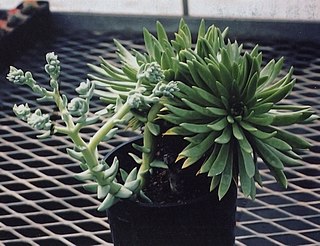
Dudleya guadalupensis is a very rare species of succulent perennial plant in the family Crassulaceae commonly known as the Guadalupe liveforever. It is a rosette-forming leaf succulent, with foliage that is variously colored light green, green, and a waxy white. It is characterized by dense leaves that fold over the center in dormancy, a curving, sinuous flower stalk, and white, cup-shaped flowers. It is endemic to the rocks and islets off of Guadalupe Island, an isolated volcanic island in the Pacific Ocean located 241 kilometers off of the coast of Baja California.

Dudleya pauciflora is a species of succulent plant in the stonecrop family known by the common name few-flower liveforever. It is characterized by its small crowded rosettes of narrow leaves and its colorful inflorescence with red-yellow flowers. Found growing on rocky outcrops and cliffs in the high elevation mountains of the Sierra de San Pedro Martir and the Sierra de San Borja, it is endemic to the state of Baja California, Mexico.

Dudleya rubens is a species of succulent perennial plant in the family Crassulaceae known by the common name as the San Francisco liveforever, native to the mountains of Baja California Sur. It is a rosette-forming plant with waxy leaves, characterized by branching stems and dull red to apricot flowers. It is only found above 500 metres (1,600 ft) in the Sierra de San Francisco and the Sierra de la Giganta ranges in Baja California Sur, primarily on north-facing volcanic slopes.

Dudleya nubigena is a species of succulent plants in the family Crassulaceae. It is a rosette forming perennial with flattish leaves. Endemic to southern Baja California Sur, the species is found in the Sierra de la Laguna and the surrounding lowlands, and on Cerralvo Island.
Dudleya cymosasubsp. costatifolia, known commonly as the Pierpoint Springs dudleya or the Pierpoint Springs liveforever, is a species of succulent plant in the family Crassulaceae, narrowly endemic to a locality in Tulare County, California, United States. It is a clumping plant with small rosettes and bright yellow flowers, resembling alpine cushion plants.
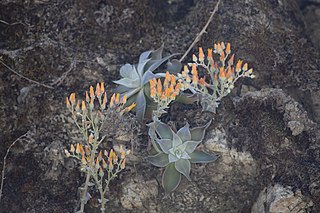
Dudleya cymosasubsp. pumila, most commonly known as the low canyon dudleya, chalky canyon dudleya or California live-forever, is a species of perennial succulent plant. It has diamond to spoon shaped leaves, sometimes coated with a fine white powder, and in May through July, bright red, orange or yellow flowers adorn the short inflorescence. A leaf succulent primarily found growing in rocky cliffs and slopes, it is endemic to California, and grows in the Transverse Ranges and South Coast Ranges, with some outlying populations. A variable plant, in some localities it is difficult to distinguish from other plants in the genus.

Dudleya cymosasubsp. cymosa is a species of succulent perennial plant in the family Crassulaceae native to California. It is the autonymous subspecies for Dudleya cymosa, and is known by the common name canyon liveforever. It is native to the California Coast Ranges, the Sierra Nevada and the Santa Monica Mountains. It is characterized by bright-yellow, orange or red flowers and broad, wide leaves. This plant is commonly found growing on rocky outcrops, talus slopes, and in shaded canyons.
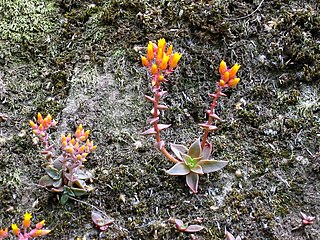
Dudleya cymosa subsp. marcescens is a species of summer-deciduous succulent plant known commonly as the marcescent dudleya or marcescent liveforever. Throughout the months of spring, it is characterized by a bloom of small, bright-yellow flowers with 5 petals, tinged with orange or red. It is a leaf succulent with a basal rosette, with the foliage withering in summer, going completely leafless, a neotenous trait in the genus. This species is endemic to the exposed volcanic rock of the Santa Monica Mountains in California, being found on shady slopes and outcroppings. It differs from its local congeners with its deciduous habit, slender caudex, and narrower leaf shape, although it is superseded in some of these characteristics by Dudleya parva, growing 13 km to the north, which has even narrower leaves and is quicker to lose them. Because of its restricted distribution and small size, it is vulnerable to habitat degradation and disturbance from acts of graffiti and rock climbers. It is listed as threatened by the United States Fish and Wildlife Service.
Dudleya virens subsp. extima is a subspecies of succulent plant in the family Crassulaceae commonly known as the Guadalupe green liveforever. It is a rosette-forming leaf succulent, with both green and white waxy foliage. It has white flowers with spreading petals that bloom from May to June. It is a somewhat small plant, continuing a southward trend of decreasing size relative to other Dudleya virens subspecies. This plant is endemic to Guadalupe Island in the eastern Pacific Ocean, which is 241 kilometers off of the Baja California coast. It is very rare, with this plant only surviving on sheer cliff faces and canyons, out of the reach of the former feral goat population rampant on the island. It closely resembles a miniature version of Dudleya virens subsp. virens, but it may be more nearly related to the local Dudleya guadalupensis.

Dudleya cymosasubsp. agourensis, commonly known as the Agoura Hills dudleya or Agoura Hills liveforever, is a species of perennial succulent plant. A rare and critically imperiled species from the Santa Monica Mountains in California, it is characterized by glaucous, gray-purple leaves, bright yellow flowers, and ascending bracts. A leaf succulent, it is found growing on west to northwest-facing open, rocky volcanic slopes.


